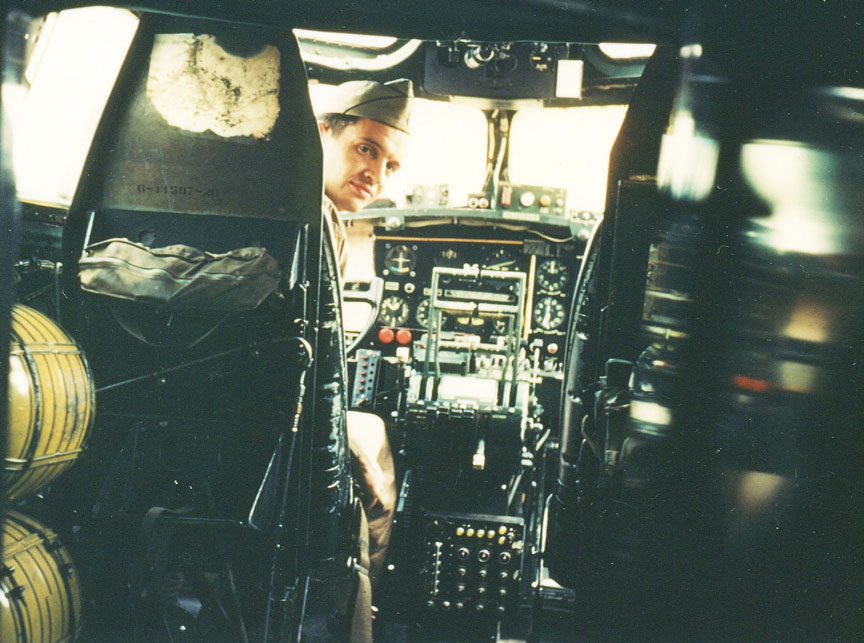Lt. Bob Welty inside B-17 - 1945
Below are two very detailed color photos of Lt. Bob Welty inside a B-17 taken by his father while Bob was in Pittsburgh after the war.
The photos are unusual as they are in color and thus represent a better feel for the various colors of the uniforms and the interior colors of the B-17 during the period 1944-45. In addition, these two photos show very detailed looks inside of the cockpit and fuselage of a war time confirgured B-17. Many thanks to Bob Welty for making these unique photos available. If you would like to add information about this photograph, please contact our Aircraft Photo Coordinator. Please include the title.
List of Bob Welty Color Photos
- The Tarr Crew in B-17 Training - 1944
- Lt. Bob Welty's Mission Photos for 14, 15 and 19 February 1945
- Lt. Bob Welty and Friends in Nuthampstead - late 1944/Early 1945
- Lt. Bob Welty inside B-17 - 1945
See also:
Bob Welty was in the Joe Tarr 398th, 603rd Crew during training. The Tarr Crew during training was:
- Lt. Joe Tarr, Pilot
- Lt. Bob Welty, Co-Pilot
- Lt. Wally Small, Navigator
- Lt. Bob Gaynor, Bombardier
- S/Sgt. Russ Currier, Engineer
- Cpl. Arthur Jones, Radio
- Cpl. Harold Clyne, Ball Turret
- Cpl. Al Dougherty, Waist Gunner
- Cpl. Maury Newcomer, Waist Gunner
- Cpl. Bill Fleming, Tail Gunner

Pittsburgh Photo No. 1: This is a photo of Lt. Bob Welty in a B-17 after the war in Pittsburgh. The photo was taken by his father. In May 2006, we asked Wally Blackwell, former B-17 pilot to comment on what he saw in this very clear photo of the cockpit of a war time configured B-17. Here are his comments: "Really special because it shows so much of the details you don't see in any restored B-17's. The yellow canisters are standard oxygen tanks. There were three on either side of the cockpit on the walls. The pilot's side for him and the navigator. The other side for the co-pilot, engineer and bombardier. These systems were intercomnnected. There were another six or so under the cockpit floor for the back half of the plane. There were a tank or two in the radio room. A few smaller for connecting walk around, one in the engineer turret and back in the radio room. One tank would last one individual for about 5 or 6 hours. It was the engineers responsibility to keep the oxygen balanced. The armor plate [on the back of the pilot's seats], really unique to see, was 1/2 inch thick or more. There was also some under the pilot's seats. The square box at the bottom is the auto pilot and above that is the prop pitch controls. The white lever is to lock them into postion when they are set. Above that the throttle quadrant, configured to let each engine to be controlled indivdually, but also in unison. The bottom split bar for engines 2 and 3. The top for 1 and 4 (like for taxiing) and grasping the middle bar, moves them all in unison, like for take off. The red buttons are the 1 and 2 prop feathering, above that, altitude indicator, and above that the old needle and ball. Below the red buttons, it looks like the right foot control for the rudder and right brake. The box on top of the dash was a distress call. If used like in a ditching, you picked up the cover over the switch on the left of the box. The cables up the middle of the windshield went up to radio equipment overhead on the bottom of the roof. A nice neat and tidy place to do business!" Merwin Genung, former B-17 pilot wrote "that on the shelf on the back of the pilot's seat it looks like an Aviator's Kit Bag AN 6505-1 Property of the US government. We used it to carry our heavy jacket's, etc. My wife has one in the garage". Welty Photo No. 2007 |

Pittsburgh Photo No. 2: This is a photo of Lt. Bob Welty in a specially equipped B-17 after the war in Pittsburgh. The photo was taken by his father. In May 2006, Geoff Rice indicated that "I am sure that the aircraft is a B17-G, and that the equipment is part of the Radar dome installation, which was usually installed in the UK." In May 2006, we asked Wally Blackwell, former B-17 pilot to comment on what he saw in this fuselage of a war time B-17. Here are his comments: "Real quantry. Both Merwin Genung, former B-17 pilot (on his own) and I thought first, is this really a B-17? It looks bigger across than it should be. I found a picture in a Roger Freeman book of the waist area with the regular ball turret installed, we are now conviniced it is a B-17, from the overhead cable slots and the rib spacing, etc. There is some unknown instrumentation in the ball turret hole. It could be some of the "mickey" type receiver equipment, going to the mickey operator in the radio room. The sun is shining though a huge hole in the fuselage where the gun window was. The black box, etc. on the left seems oriented like camera out the left gun window." Newt Moy commented that the uniform that Bob Welty is wearing was called the "Suntan Uniform". These were left behind in the US before crews shipped over to the UK. Bob Welty's son, Scott made the following comments in October 2006:
Welty Photo No. 3008 |
